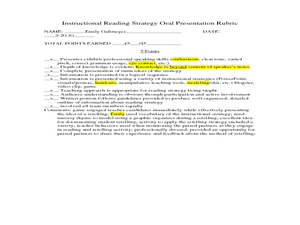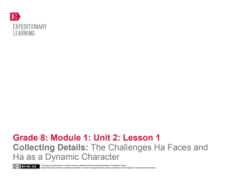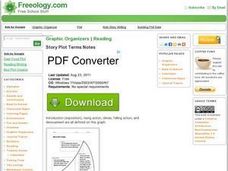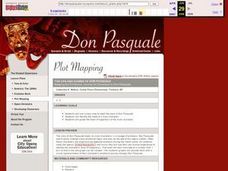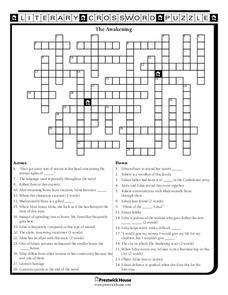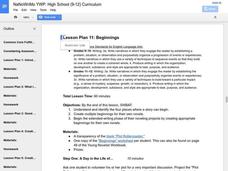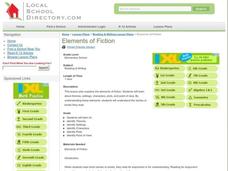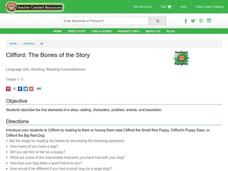Pinecrest Preparatory Middle and High School
Short Story Planning Guide
A short story is only as strong as its characters, development, and conflicts. Encourage the young authors in your class to plan their stories based on the elements of narrative writing, all provided in brainstorming graphic organizers.
Curated OER
Retelling
Explore language arts by completing a story worksheet in class. Readers will identify the importance of plot, setting, and character while they write their own short story. They also retell their story to a classmate and participate in a...
EngageNY
Collecting Details: The Challenges Ha Faces and Ha as a Dynamic Character
What is a dynamic character? Using an interesting resource, scholars set out to answer the question. They create graphic organizers to collect details about character development as they read the novel Inside Out & Back Again. They...
Pace University
Short Stories
A reading of Kevin Lamb's short story "Lost in the Woods" launches a study of how writers use elements such as foreshadowing, mood, character development, setting, and conflict to engage readers. Class members then demonstrate what they...
Curated OER
Story Plot Terms
This literary terms handout defines introduction, rising action, climax, falling action, and denouement.
Curated OER
The Ups and Downs of don Pasquale: Mapping the Emotional Journey of Characters in Don Pasquale
Students listen to and retell the story of Don Pasquale. They evaluate the emotions of the main characters. Students create a graph of the emotions of Don Pasquale.
Curated OER
Pop-Up Puppets
Students read "Peter Spier's Circus!" and identify the literature's setting and characters. They work in small groups to create a circus stage set and puppets based on their reading. Students perform a puppet show using their set and...
Curated OER
Story Elements
Students create a "character T-shirt" that exemplifies their ability to analyze a character. The students also compare and contrast characters in a given story. Finally, the students write a presentation about the story's characters,...
Curated OER
Story Mapping
Help your learners map a story with a graphic organizer provided. Four squares for setting, problem, characters, and solution surround the circle for theme. Use this with any story you may be reading to go over important...
Curated OER
The Too Small House: Story and Craft Activity
Engage students in setting and character with this story and craft activity set. To begin the activity, learners read the short story "The Too Small House." They then cut out and color a picture of the house and paper figures of the...
Curated OER
Academic Vocabulary
Arm your writers with an arsenal of literary terms. With definitions of everything from plot structure and figurative language to point-of-view and types of irony, learners will gain an understanding of elements in stories and be able to...
Curated OER
"The Gunny Wolf": American Folktale
While you tell the story of "The Gunny Wolf," your class will actively participate by asking questions and clarifying. Next, they answer questions about the story to increase comprehension before creating a storyboard to document the...
Prestwick House
The Awakening
Kate Chopin's classic American tale, The Awakening, is the focus of a review worksheet. High school readers read the clues about the novel's characters, plot, and important quotes to fill in a crossword puzzle.
Prestwick House
The Glass Castle
Jeannette Walls' memoir, The Glass Castle, grapples with the idea that loving someone may or may not include forgiving them for their past behavior. Take a look at a crossword puzzle that reviews characters, plot points, and key details...
Curated OER
Lesson Plan 11: Beginnings
Every good novel needs a solid beginning! Setting the stage can have your budding authors stumped, so use this lesson to get them thinking. After examining the plot rollercoaster image (included) they consider the four places...
Curated OER
Lesson Plan 17: Novel, Take 2
It's all about using peer resources in this writing process lesson, which includes a fantastic novel revision worksheet packet. Learners have read a partner's story draft the night before, and groups have a "lightning round of...
Scholastic
A Tale to Tell!
A creative spin occurs when one pupil acts as author Ann M. Martin. Using a Q & A at the back of her book A Dog's Life, other classmates ask the "author" questions. They discuss the reasons why they know the book is from a...
Curated OER
Elements of Fiction
Learners identify key story elements in a fiction text. In this literacy lesson, students are introduced to the various elements of fiction such as the setting, plot, and theme. Learners read a short story of their choice and identify...
Curated OER
Text Under the Microscope
Students explore plot, setting, point of view, and theme. In this literary elements lesson plan, students read "The Cask of Amontillado," by Poe and the War of the World script by H.G. Wells. Students identify and define...
Curated OER
Lesson Plan 2: Good Novel, Bad Novel
What are the characteristics of a good piece of writing? What makes a story interesting? Give your pupils a chance to define the qualities of good novels and what they see as the qualities of bad novels. Class members record these...
Curated OER
Story Elements
Third graders identify story elements. In this story elements lesson, 3rd graders look at main idea, characters, point of view, theme and setting. They create a five paneled comic strip from a book.
Curated OER
Egg Carton Stories
Students create stories with better structure when they are able to focus on its characters, setting, and plot. Teacher creates settings, character, and problem cartons with information written on strips of paper.
Curated OER
Identifing Elements of Narrative Writing
Learners explore the concepts of narrative writing. They identify the basic elements in narrative writing such as the setting description, characters, conflict, climax and resolution. Using five adjectives from a previous spelling unit,...
Curated OER
The Bones of the Story
Learners describe the five elements of a story--setting, characters, problem, events, and resolution. They use the Clifford series of books, and a worksheet imbedded in this lesson to help them explain the five elements of a story.
Other popular searches
- Setting Plot Main Characters
- Plot, Characters and Setting
- Plot Characters and Setting
- Plot Setting Characters

